Invented by Jay S. Bryant, Edgar A. Fereira, Adeia Guides Inc
User-defined rules for assigning destinations of content refer to the ability for users to create their own criteria or conditions that determine where their content should be sent. This can include factors such as keywords, tags, categories, or even specific audience demographics. By setting up these rules, users can automate the process of content distribution, saving time and effort in manually assigning content to different destinations.
One of the main drivers behind the growing market for user-defined rules is the increasing complexity of content distribution channels. With the rise of social media platforms, email marketing, content management systems, and other online channels, businesses and individuals are faced with the challenge of managing multiple platforms simultaneously. User-defined rules provide a way to simplify this process by allowing users to define once how their content should be distributed across various channels.
Another factor contributing to the market growth is the need for personalized content experiences. In today’s digital age, consumers expect content that is tailored to their specific interests and preferences. User-defined rules enable businesses to deliver personalized content experiences by allowing them to segment their audience and deliver targeted content to different groups. This not only improves the user experience but also increases engagement and conversion rates.
The market for user-defined rules is also driven by the increasing demand for automation and efficiency. As businesses and individuals strive to do more with less, automation has become a key strategy for streamlining operations. User-defined rules offer a way to automate the content distribution process, reducing the need for manual intervention and freeing up resources for other tasks.
Furthermore, the market for user-defined rules is fueled by advancements in technology. With the advent of artificial intelligence and machine learning, users can now leverage these technologies to create more sophisticated and intelligent rules. For example, AI-powered algorithms can analyze user behavior and preferences to suggest optimal rules for content distribution.
In conclusion, the market for user-defined rules for assigning destinations of content is experiencing significant growth due to the increasing complexity of content distribution channels, the need for personalized content experiences, the demand for automation and efficiency, and advancements in technology. As businesses and individuals continue to generate and consume more content online, user-defined rules offer a valuable solution for organizing and distributing content effectively.
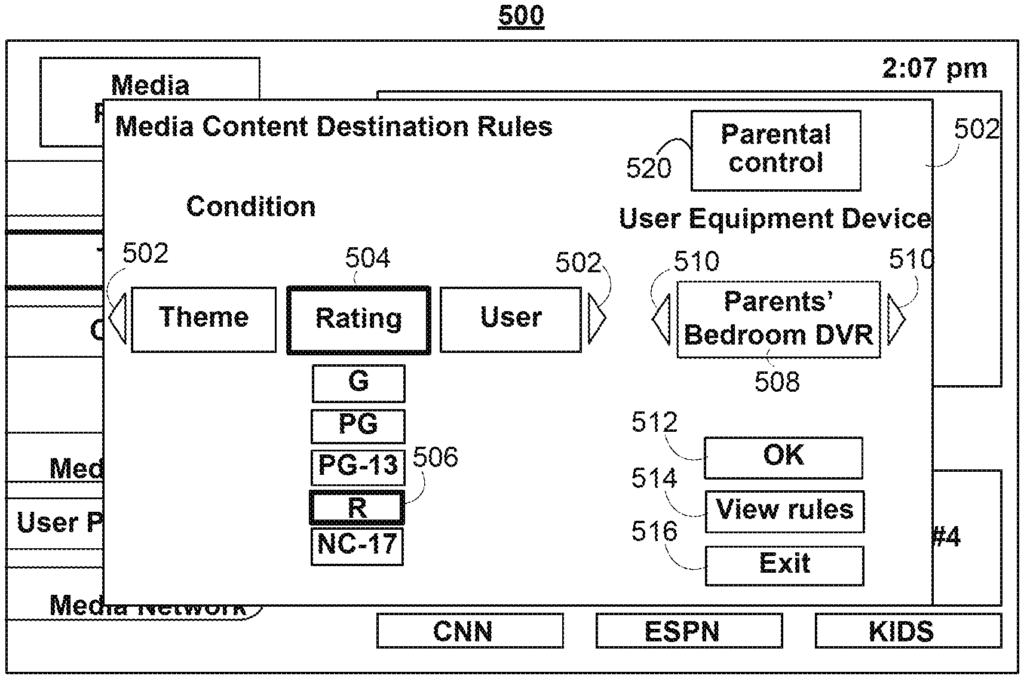
The Adeia Guides Inc invention works as follows
Users can create rules to assign user equipment devices to media content through a media guidance application. A user can, for example, define a rule that selects media content with attributes that meet a predefined condition and downloads, records, or streams it to a specific user equipment device. The user can define and manage media guidance menus and restrict other users’ access to the rules.
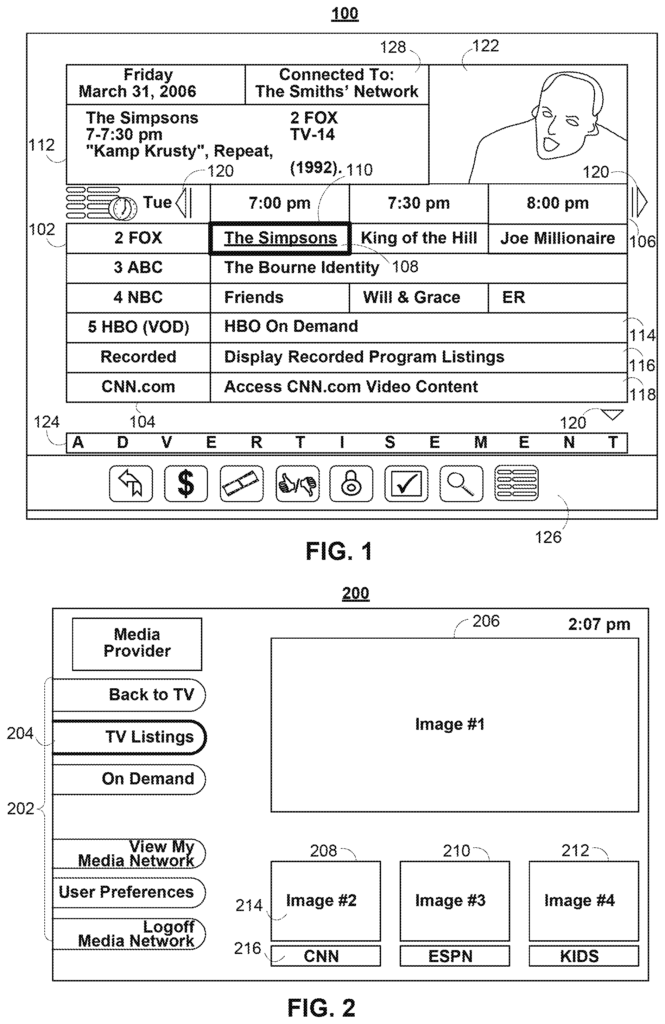
Background for User defined Rules for Assigning Destinations of Content
This invention relates to the creation of rules for assigning user equipment devices as destinations of media content.
Users can set up a record by using interactive media guidance apps, such as interactive TV program guides. They select a program, and then a device to record it. Some interactive media guidance apps automatically select the device that will record the program scheduled for recording, based on its availability and capability. If a user owns two recording devices, for example, the media guidance app may automatically record the scheduled program on the device that was originally scheduled. The media guidance application can also automatically select a recording device with enough space to record the program, for example if one device is full. Another example is that the media guidance app may automatically record the program on a device which does not cause conflict (e.g. if all tuners are scheduled to be used).
It would be desirable, therefore, to have a media guidance app that accepts user-defined rules for automatically assigning recording devices to particular recordings. It would also be desirable to have a media guidance app that accepts user-defined rules for assigning user equipment devices as destinations for media content.
According to the principles of the invention, an interactive guidance application for media content receives rules that are defined by users for assigning user equipment devices as destinations for media content. The interactive media guidance application, for example, may receive a set of rules identifying a particular recording device. The interactive media guidance app may also receive a rule that identifies the device used to record a recording. Another example is that the interactive media guidance app may receive a guideline identifying a device to stream or download media content.
An user may be able to access a number of user equipment devices which together form the user’s network. The user can define rules to assign specific user equipment devices media content destinations. This allows the user to control media content stored on the devices in their media network. The user can define a rule by first defining one or more conditions to identify media content that the rule will apply. The conditions can include any number of attributes, such as genre, theme or title, actor or rating, and user rankings, e.g. popularity rankings on tvguide.com. In some embodiments the attributes can be selected automatically based on user preferences (e.g. a condition that captures media content of interest to an individual user). In this embodiment, attributes may be selected based on, for instance, genre, theme and actors stored in the user’s preferences profile.
The user can also choose one or more user-equipment devices as the destination for media content that meets the requirements of a rule. The user can select, for example, one or more recording or storage devices, computers or car systems, personal multimedia devices, cell phones, or other user equipment devices. The interactive media guidance application can be used to define the rule once the user selects both the condition and the device.
In some embodiments the interactive media guidance app may require that the user authenticate or provide authorization information prior to a rule being defined or modified. The interactive media guidance app may, for example, require that the user enter a parental code before a new rule is defined. This can prevent a child setting up a rule that directs the interactive media guidance app to set their personal device as the destination for media content the parents don’t want the child to see (e.g. R-rated material).
The interactive media guidance application can store the rule at any location suitable, either within or outside the user’s network. The interactive media guidance app may, for example, store the rule at a central location, such as a server. The interactive media guidance app may also store the rule on some or all devices in the user’s network of media (e.g. only the devices that are identified in the rules, or only the devices from which the user can select content to be stored in the network). Another example is that the rule could be stored within a data structure defining the user’s network.
In some embodiments, a suitable method or process may be used to deliver media content when a specific user equipment device is the destination device. The rule can be applied, for example, to media content that is streamed (e.g. on-demand), cached, webcasts or any other process suitable for providing media. Another example is that the rule could direct the interactive media guide application to transfer an already recorded program to a specific user equipment device (e.g. recorded using a default recording tool). In some embodiments the rules can be restricted to a single process (e.g. only streaming and recorded media content).
The user can select media content in any way that suits them. When selecting a recording program, for example, the user can direct the media guidance app to use the rules to identify the destination device. The media guidance application can use the rules to identify the destination for media content. In certain embodiments, the user can direct the media guidance app to only apply the rules to content that is selected using particular user equipment devices.
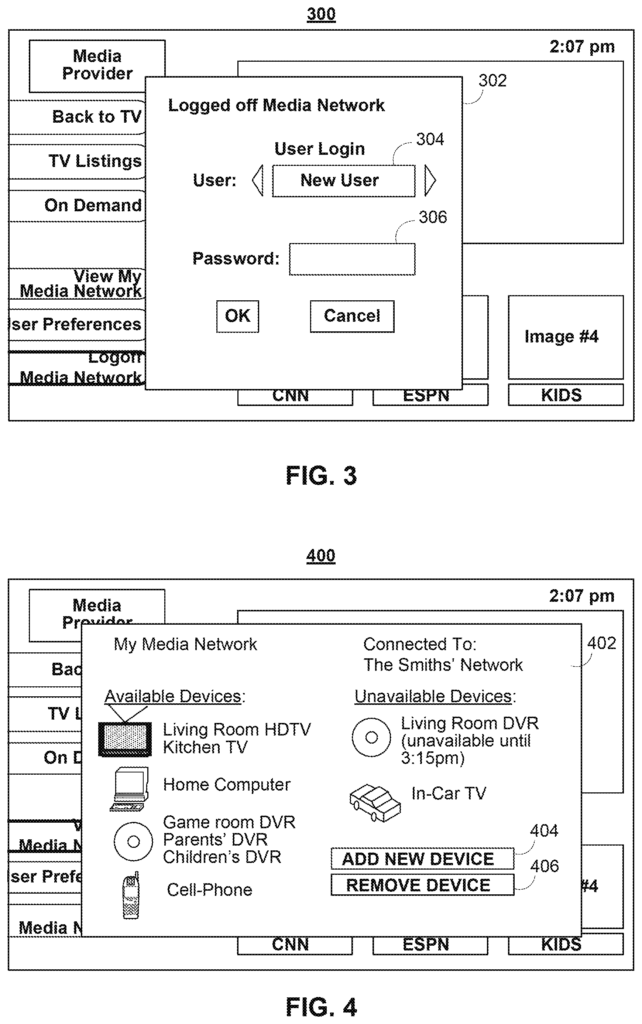
The amount of media that users can access in any media delivery system is substantial. Many users want a media guide that will allow them to navigate through media selections efficiently and identify the media they desire. The application that provides this guidance is called an interactive media guide application, or sometimes a media guide application, or a Guidance application.
Interactive media guidance applications can take on different forms, depending on which media they are guiding. An interactive television program guide is a typical example of a media guidance application. Interactive television program guide (also known as electronic program guides), are well-known applications for media guidance. They allow users to find and navigate through many different types of media including traditional television programs, pay-per view programs, video-on demand (VOD), Internet content, such as streaming media, downloads, webcasts, etc. Other types of video or media content. Guidance applications allow users to locate and navigate content related to video content, including video clips, articles or advertisements, chat sessions, videos, games etc.
With the advent and proliferation of mobile computing and high-speed wireless network, users can now access media from their personal computers (PCs), as well as other devices such hand-held computers (PDAs), MP3 players, mobile phones, in-car TV devices or other mobile devices. These devices allow users to access the same media as a TV. Media guidance is also required on these devices. Media guidance may be provided for content that is only available through televisions, media content only available through one or several of these devices or media content only available through both a TV and one or multiple of these devices. Media guidance applications can be offered as web applications (i.e. provided on a website), standalone applications, clients for mobile phones, PDAs or handheld computers. Below, we describe in greater detail the various platforms and devices that can be used to implement media guidance apps.
A user” as used herein can be a single user or a collection of users, such as members of a household or friends. To access media content, a user can use several user equipment devices such as a TV, a mobile phone, and a personal multimedia player. The user’s network of media devices is made up of the equipment used by the individual. The user’s network can be a home-based network, such as the user?s TV and computer, connected via the WIFI network. The user’s network can also include equipment connected to the Internet, or other networks such as those of the television service providers and cell phone networks (e.g. a computer at work for accessing a web-based interactive program guide, televisions in cars and multiple televisions in a user’s house). The user’s network can include devices such as the cell phone that is only used by the user. The user’s network can also include shared equipment such as a television that is used by several members of the household. In some embodiments shared equipment can be linked to a primary user, or group of users. (e.g. the television that is in the bedroom belongs to the parents while the one in the child’s room belongs the child.)
The “User Profile Information” for each user equipment device of the user’s network media may be shared among the devices in order to coordinate media guidance on each device. Coordination may involve sharing user configuration data to create a similar or common media guidance interface across all devices of the user. Coordination may include sharing preferences in order to offer coordinated media content recommendations on devices. Sharing media content information may be part of the coordination to enable a user access to recorded content, or other stored content on multiple devices. The coordination can provide additional functionality such as allowing a user to remotely control or communicate with devices on a user’s network via another device.
The media guidance application can give users the option to define rules that will assign specific devices in a user’s network of media as destination devices. These rules can automatically control the location of media content in a media network, whether it is being transmitted, stored or both. A destination device can be a device used to display or store media content (e.g. stream, download or cache). The rules can define conditions to identify media content assigned to a destination device. In some embodiments the conditions can be based upon the attributes of media content (e.g. rating, actors or high definition). In some embodiments the conditions can be based on how the media content was received (e.g. recorded, streamed, or cached). A rule, for example, may assign recordings to specific recording devices. Another example is that a rule can assign downloaded content to one device in the media network. (e.g. media content downloaded via an online store such as iTunes, Google Video or Amazon Video may be downloaded onto a user’s own media device.) Another example is that a rule can assign media content streaming from a server, such as a VOD, or provided via a webcast, to a specific user device.
The media guidance application provides users with media listings and information about media. FIGS. FIGS. The screens in FIGS. The display screens shown in FIGS. The displays in FIGS. While FIGS. The user can indicate that they want to access media content by selecting an option on a display screen. (e.g. a menu, listings, icon, hyperlink, etc.). Pressing a GUIDE button on a remote or other input device or interface (e.g. The media guidance application can display media information in response to a user’s input in several different ways. For example, it may organize media information by time or channel, media type, category (e.g. movies, sports news, children or other categories), or any other predefined or user-defined criteria.
FIG. Grid program listing display 100 is shown in FIG. 1, arranged by channel and time. It also allows access to multiple media types on a single screen. Grid 102 may be included in display 100. It includes: (1) a column with channel/media types identifiers (which are cells in the column), where each cell identifies the different media types or channels available; (2) a row with time identifiers (which are cells in the row), where each cell identifies the time block. Grid 102 includes cells for program listings such as listing 108. Each listing contains the title of the associated program, along with the channel and time. A user can select programs by moving the highlight region 110 with an input device. Program information region 112 may contain details about the selected program listing. The program information region 112 can include the following: the title of the program, its description, when it is broadcast (if applicable), which channel (if applicable), and any other desired data.
The media guidance application provides access to both linear and non-linear content, which are not scheduled. Non-linear content can come from a variety of media sources, including VOD (video on demand), streaming media (downloadable media), and Internet consent. Locally stored media content can include video content on digital video recorders (DVRs), DVDs, cassettes, CDs, etc. Other media content that is not time sensitive can be used. On-demand media may include movies as well as original content from a specific media provider. (For example, HBO On Demand provides ‘The Sopranos’ and ‘Curb Your Enthusiasm? “Curb Your Enthusiasm” and “The Sopranos”. HBO On Demand, The Sopranos, and Curb Your Enthusiasm are trademarks of the Home Box Office, Inc. Internet Content may include web events, like a Webcast or chat session, or media available on demand as streaming media or as downloadable media via an Internet web page or other Internet access. FTP).
Grid 102 can provide listings of non-linear content, such as on-demand listings 114, recorded media listings 116, or Internet content lists 118. Mix-media is a term used to describe a display that combines listings from different media types. display. Display 100 can be changed to display different listings based on the user’s selection or a guidance application definition. (e.g. displaying only broadcast and recorded listings, only broadcast and on-demand listings, etc.). Listings 114,116,and118 span the entire grid 102 in order to show that selecting these listings can provide access to an on-demand listing, recorded listing, or Internet listing display. Other embodiments may include listings for these types of media directly in grid 102. The user may see additional listings when he or she selects one of the navigational icon 120. Pressing the arrow keys on a user-input device can affect the display similarly to selecting navigational icons.
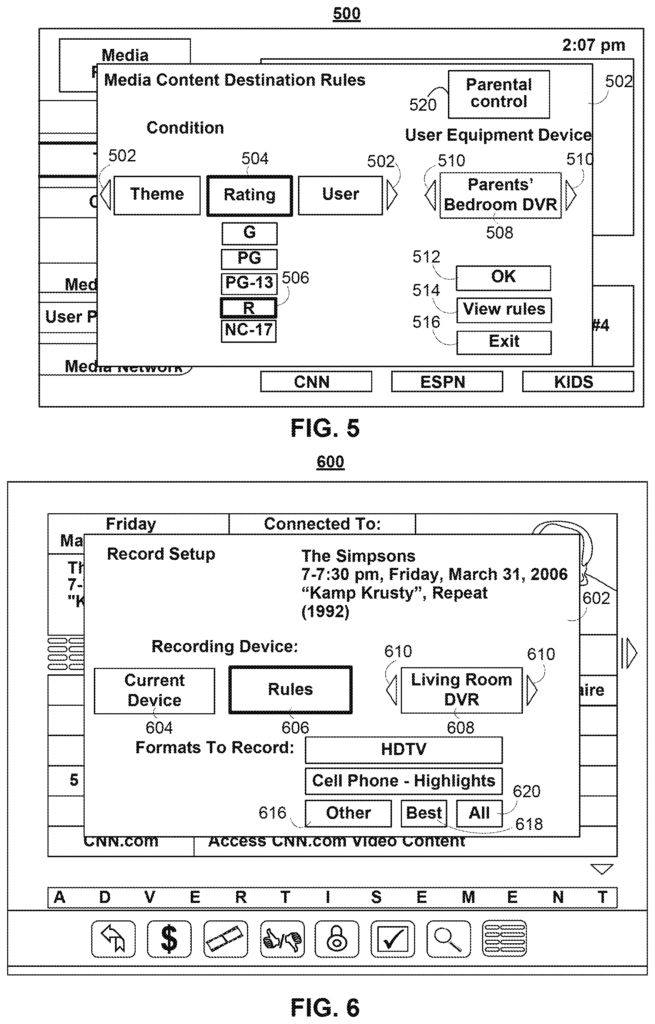
Display 100 can also include video regions 122, advertisements 124, options regions 126, as well as user media network ID region 128. The user media network identification region 128, may be used to identify the current user media network that the media guidance application belongs to. Video region 122 may allow users to preview and/or view programs that are available now, will be available soon, or have been available to them. Video region 122 can be a separate or corresponding area to the grid 102. Grid displays that include a video area are also known as Picture-in-Guide (PIG). Satterfield et al. describe PIG displays in more detail. U.S. Pat. No. No. U.S. Pat. No. No. “PIG displays can be used in other media guidance applications display screens of this invention.
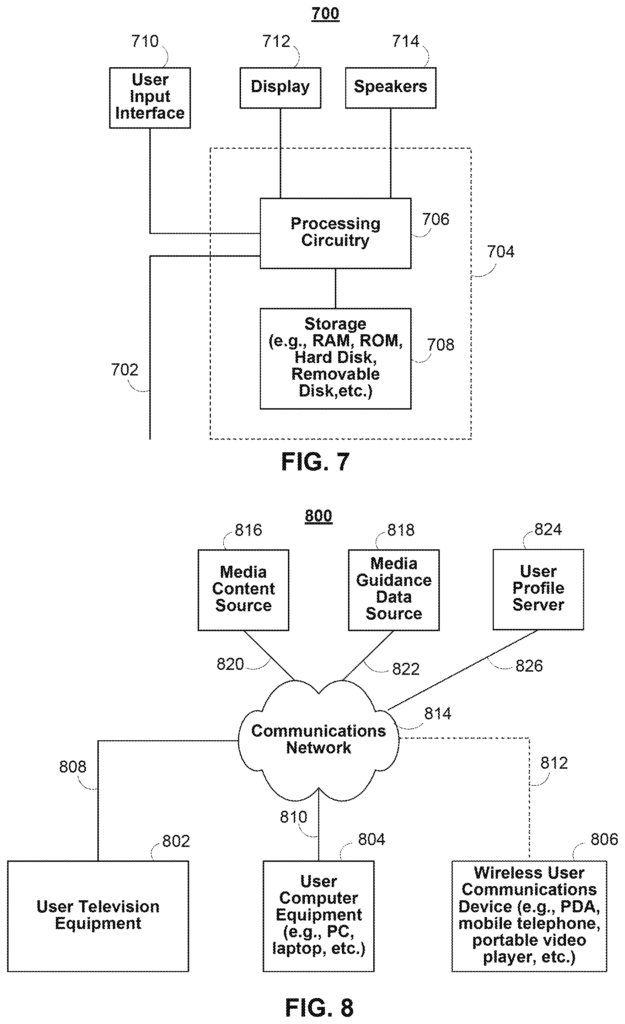
Click here to view the patent on Google Patents.
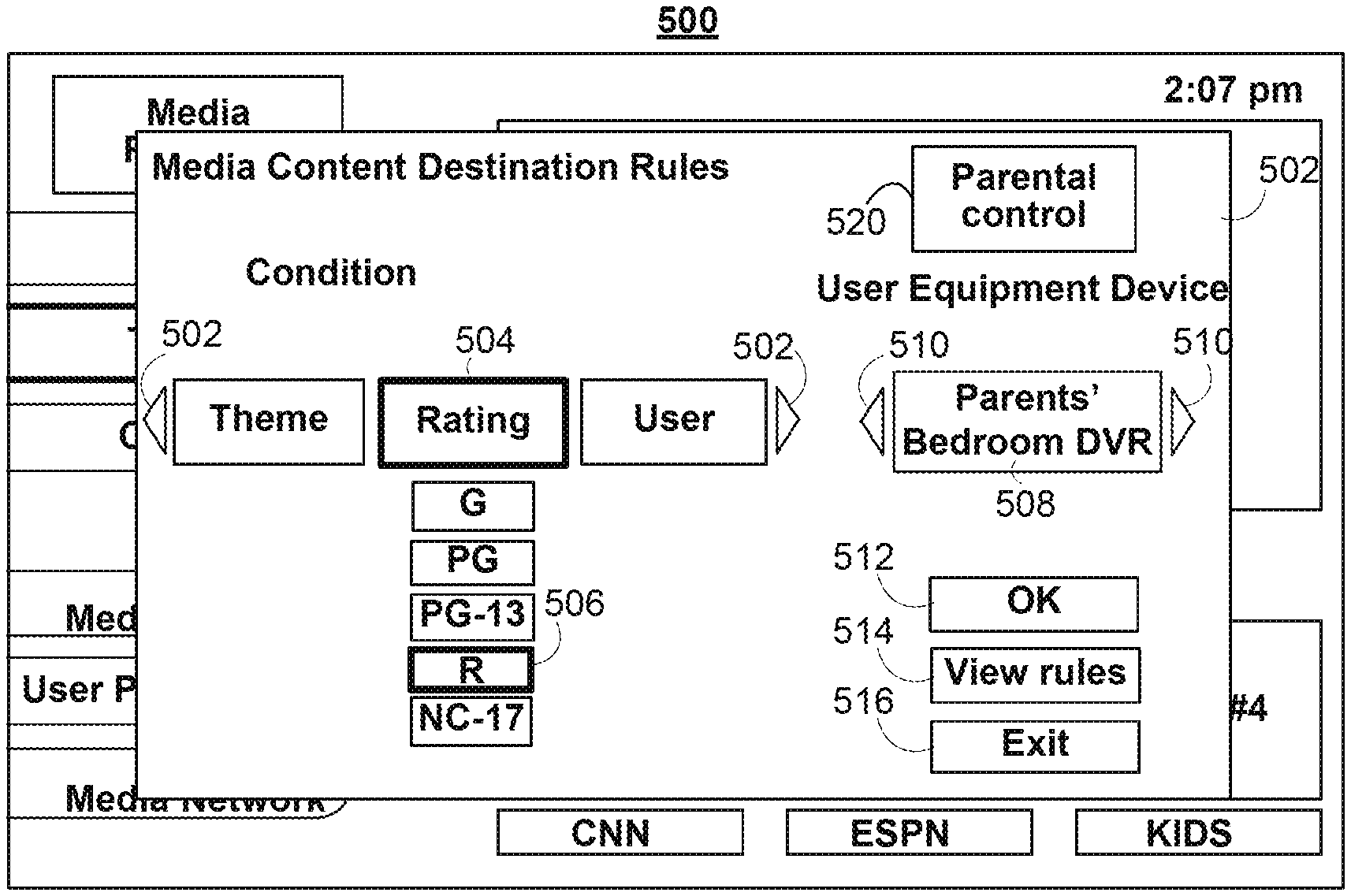
Leave a Reply